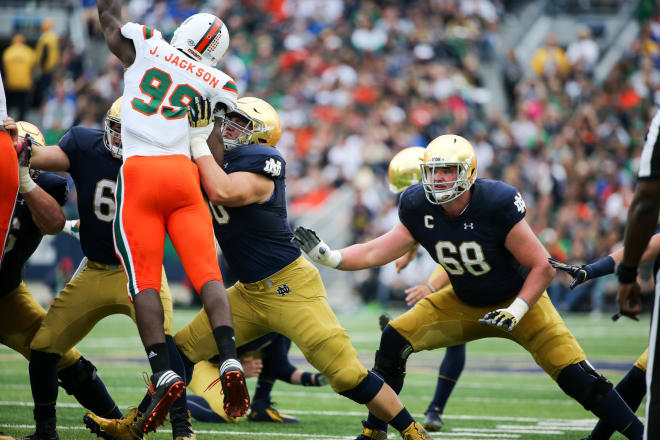Notre Dame-Navy: The 'Other' Side Of The Matchup

Every year when Notre Dame plays Navy, the pregame banter usually centers on how much the Fighting Irish defense can slow the Midshipmen’s vaunted triple-option attack that annually places among the top three nationally in rushing offense.
Seldom does the spotlight turn to how Navy’s defense can stop Notre Dame’s offense, which is generally the game’s biggest mismatch. In the last five meetings between the two teams, head coach Brian Kelly’s offense has tallied 56, 50, 38, 49 and 41 points against the Mids, or an average of 46.8 points per contest.
During that span, Notre Dame has had 51 full possessions (not including killing the clock or “taking a knee” to end a half), and punted only six times (11.8 percent of the time).
In those 51 series on offense, Notre Dame also ended up scoring a touchdown 32 times (62.7 percent), kicked four field goals, missed two field goals and committed seven turnovers to go with the six punts.
Navy will get its share of yards, especially rushing, and put points up on the scoreboard to make the game competitive. However, its best chance of winning is if it can force three or four turnovers — or have at least a plus-two advantage in that area.
For example, Navy had zero turnovers in its last two wins versus Notre Dame in 2010 (35-17) and 2009 (23-21), while the Irish had three and two, respectively.
Because Navy shortens the game while keeping the clock moving with its ground-oriented attack, Notre Dame will have fewer series on offense to score. In an average game against a more conventional offense the Irish could have a dozen or more possessions, but versus Navy it could be nine or less. In the first half of the 17-10 loss to Stanford Oct. 15, Notre Dame had only four possessions.
“We understand our role on offense is to put points on the board as many times as we can because we know our possessions are going to be limited,” senior left tackle Mike McGlinchey summarized.
Overall, the Irish have been proficient against Navy at scoring early and then consistently once it gets on a roll:
• In 2011, Notre Dame scored touchdowns on five of its first six series on offense to take a commanding lead in the 56-14 win.
• In 2012, the Irish reached the 50-point mark again by tallying TDs on five of its first six series, plus a fumble return for a score by defensive lineman Stephon Tuitt.
• In the 38-34 win in 2013, Notre Dame had only eight full series but scored five touchdowns and a field goal to atone for two interceptions. It reached the end zone on three straight second-half possessions to regain the lead.
• In 2014, Notre Dame scored touchdowns on each of its first four series to build a 28-7 cushion, only to fall behind 31-28 before posting a hard fought 49-39 win.
• Last year was an anomaly when the Irish actually punted on two of their first three possessions (with a TD in between). Then on its last seven full series (including a field goal drive when it took the ball with only 24 seconds left until halftime), Notre Dame scored four touchdowns, two field goals and threw an interception.
----
• Talk about it inside Rockne's Roundtable
• Subscribe to our podcast on iTunes
• Learn more about our print and digital publication, Blue & Gold Illustrated.
• Follow us on Twitter: @BGINews, @BGI_LouSomogyi, @BGI_CoachD,
@BGI_MattJones, @BGI_DMcKinney and @BGI_CoreyBodden.
• Like us on Facebook
